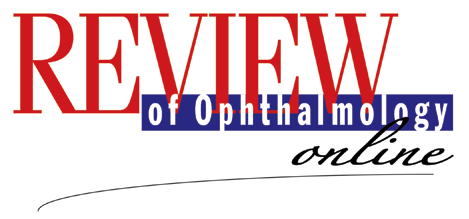
|
Volume 9, Number 13
|
Monday, April 6,
2009
|
| In this issue: (click heading to view article) | ||||
| From the Editor: Medical Care Versus Health Care | ||||
| Monitoring Treatment Progress with Anterior Segment OCT | ||||
| Glitazone Use and Diabetic Macular Edema | ||||
| Interferon Alpha Treatment for Chronic CME | ||||
| Briefly | ||||

|
||
 |
||
| Monitoring Treatment Progress with Anterior Segment OCT This Polish study evaluated the usefulness of anterior segment optical coherence tomography (AS OCT) for initial diagnosis and monitoring treatment results in eye injury cases. A total of 38 eyes of 34 patients (mean age = 33.8 years) with different types of ocular injuries (penetrating injury [8 eyes], perforating injury [2 eyes], intraocular foreign body [4 eyes], ocular burn [9 eyes], contusion [13 eyes] and lamellar laceration [2 eyes]) were examined and AS OCT examination was performed at the initial visit, directly after injury and repeated as treatment progressed. Both anterior chamber components and corneal pachymetry were evaluated.
Slit lamp exam did not provide a clear diagnosis in three eyes after contusion because of a nontransparent cornea. In one case of a 44-year-old male patient, only corneal edema was noticed during slit lamp exam, whereas AS OCT revealed Descemet's membrane detachment. And in a 17-year-old male patient with blood infiltrating the cornea, OCT revealed acute angle closure with a pupillary block. OCT was valuable for monitoring the corneal healing progress after amniotic membrane application in patients with corneal burns and was also useful for determining whether a lamellar or penetrating technique should be applied in patients who qualified for corneal transplantation. Additionally, AS OCT was helpful in establishing the localization and size of foreign bodies in patients with foreign bodies. AS OCT was determined to be a very valuable tool for early diagnosis and monitoring treatment progress in ophthalmic departments dealing with ocular trauma. |
|
SOURCE: Wylegala E, Dobrowolski D, Nowinska A, Tarnawska D. Anterior segment optical coherence tomography in eye injuries. Graefes Arch Clin Exper Ophthalmol 2009; 247(4):451-455. |
 |

|
||
| Glitazone Use and Diabetic Macular Edema To determine the ocular safety of glitazones (a class of oral hypoglycemics) in diabetic patients, researchers conducted a prospective cohort study to investigate the association of diabetic macular edema (DME) in a large population of glitazone users.
They identified approximately 170,000 patients with diabetes using the Diabetes Case Identification Database and obtained information on glitazone drug use from the pharmacy database. The main outcome measure was the development of macular edema (ME). The researchers used the x2 test to compare proportions and t tests for means. Additionally, they used logistic regression analysis to adjust for potential confounding variables. A total of 996 new cases of ME cropped up in 2006 and the researchers found that glitazone users were more likely to develop ME in 2006 (odds ratio [OR], 2.6; 95% confidence interval [CI], 2.4 to 3.0). After excluding patients who did not have the drug benefit, did not have an eye exam and had an HgA1c <7.0, glitazone use was still associated with an increased risk of developing ME (OR, 1.6; 95% CI, 1.4 to 1.8). According to the researchers, their study appears to show that the glitazone class of drug is associated with DME and that, even after adjusting for confounding factors of age, glycemic control and insulin use, glitazones are still modestly associated with DME. A more in-depth study is needed to evaluate the role of other confounding factors. The researchers advise that when treating DME patients, ophthalmologists consider the role of the glitazones. |
|
SOURCE: Fong DS, Contreras R. Glitazone use associated with diabetic macular edema. Am J Ophthalmol 2009;147(4):583-586. |
 |
| Interferon Alpha Treatment for Chronic CME In a retrospective analysis of an interventional case series, the authors aimed to assess the efficacy and tolerability of interferon (IFN) alpha in chronic cystoid macular edema (CME) due to non-infectious uveitis. They found that their data demonstrate IFN alpha to be an effective and well-tolerated therapy for chronic refractory uveitic CME. IFN alpha-2a was administered at an initial dose of 3 or 6 million IU per day subcutaneously and tapered afterwards to the lowest possible dose to maintain the absence of CME. Efficacy of treatment was assessed using optical coherence tomography. A total of 24 patients with chronic CME (median duration 36.0 months) due to noninfectious anterior (n=2), intermediate (n=18) or posterior (n=4) uveitis have been analyzed. According to the authors, ineffective pre-treatment included systemic corticosteroids (all patients), acetazolamide (22 patients) and at least one immunosuppressive drug (18 patients). IFN therapy was shown to be effective (= complete resolution of CME within 3 months, able to taper IFN) in 15 patients (62.5%), partly effective (= incomplete resolution of CME, unable to taper IFN) in 6 patients (25.0%) and not effective (= no response or recurrence of CME) in 3 patients (12.5%). The study authors concluded that IFN treatment was generally well tolerated. Common side effects, including flu-like symptoms; fatigue or increased liver enzymes, were dose-dependent and led to discontinuation of IFN in only 1 patient. |
|
SOURCE: Deuter CME, Kötter I, Günaydin I, et al. Efficacy and tolerability of interferon alpha treatment in patients with chronic cystoid macular edema due to non-infectious uveitis. Br J Ophthalmol 2009; Mar 24 [Epub ahead of print]. |  |

|
|
 |
|
| Subscriptions: Review of Ophthalmology
Online is provided free of charge as a service of Jobson
Professional Publications Group, a division of Jobson Medical Information LLC, 11 Campus Blvd., Newtown Square, PA 19073. If you enjoy reading Review of Ophthalmology
Online, please tell a friend or colleague about it. Forward
this newsletter or go to www.jobson.com/globalemail/ and sign up today. To
change your subscription, reply to this message and give us your
old address and your new address; type "Change of Address" in the
subject line. If you do not want to receive Review of
Ophthalmology Online, click here. Advertising: For information on advertising in this e-mail newsletter or other creative advertising opportunities with Review of Ophthalmology, please contact publisher Rick Bay, or sales managers James Henne, Michele Barrett or Kimberly McCarthy. News: To submit news, send an e-mail, or FAX your news to 610.492.1049 |












